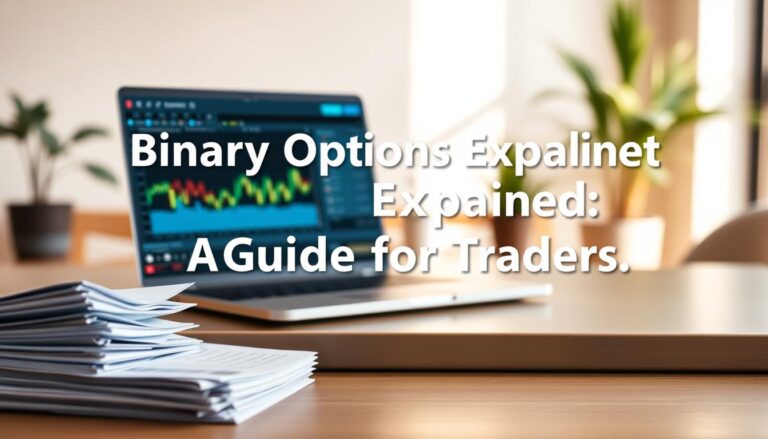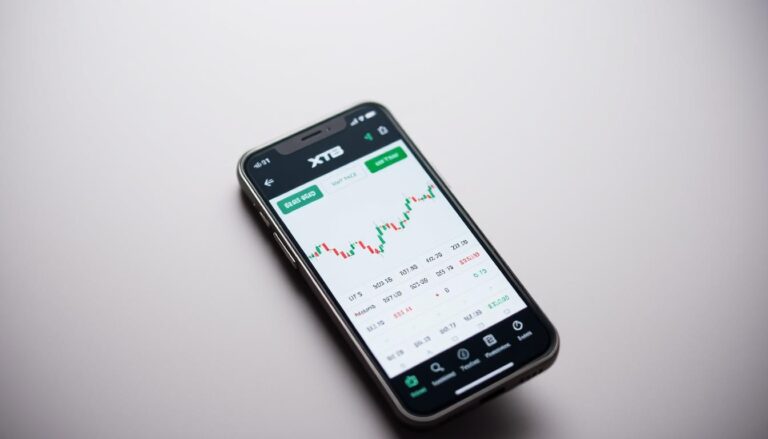Binary Options Explained, Traders Guide
Financial markets offer countless ways to speculate on price movements, but few are as straightforward as binary options. These derivatives allow traders to predict whether an asset’s value will rise or fall within a set timeframe. If correct, they receive a fixed payout. If wrong, they lose their investment entirely—a classic “all-or-nothing” outcome.
Each trade revolves around a yes/no proposition. For example, a trader might bet that gold will stay above $1,800 per ounce by 3 PM. If it does, they earn a profit—often between 60% and 90% of their stake. Two common types exist: cash-or-nothing options pay a preset amount, while asset-or-nothing options deliver the underlying asset’s value.
Regulators like the U.S. SEC caution investors about high risks, including potential scams. Meanwhile, UK traders benefit from tax-free profits under spread betting rules. This blend of simplicity and risk makes these instruments popular in fast-paced markets.
Understanding their mechanics is crucial. This guide breaks down how they work, their advantages, and pitfalls to avoid—whether you’re new to trading or refining your strategy.
Introduction to Binary Options Trading
Predicting market movements doesn’t always require deep analysis—some instruments thrive on simplicity. These contracts let traders focus on a single question: will an asset’s price be above or below a specific level at expiration?
Definition and Key Concepts
At its core, this approach involves three elements. The strike price acts as the target, while the expiration time sets the deadline. Traders receive fixed payouts—often 70-90% of their investment—if their prediction holds true.
Consider a £500 bet that Colgate shares will stay above £60 by market close. If correct, the trader earns £850. If wrong, they lose the entire stake. Outcomes hinge entirely on the underlying asset’s position relative to the strike price at expiry.
Why They Matter Today
Three factors drive their popularity in the UK:
- Short timeframes (minutes to hours) fit busy schedules
- Clear risk caps help manage volatility exposure
- Tax-free profits under spread betting regulations
This clarity attracts newcomers overwhelmed by traditional markets. Unlike complex options trading strategies, these instruments turn uncertainty into measurable scenarios.
Fundamentals of Binary Options Trading
Trading instruments vary in complexity, but few match the clarity of fixed-payout contracts. These agreements hinge on a simple premise: either the asset meets the target price at expiry, or it doesn’t. There’s no middle ground.
Breaking Down the Win-or-Lose Scenario
Consider a U.S.-based gold contract priced at $1,850 per ounce. If a trader bets $70 that gold will stay above this level by 4 PM, two outcomes exist. If gold closes at $1,855, they receive a $100 payout. If it drops to $1,840, they lose their entire stake.
This “in-the-money” versus “out-of-the-money” distinction defines success. Contracts expire profitably when the asset’s price meets the strike threshold. Brokers calculate payouts using models inspired by the Black-Scholes formula, factoring in volatility and time remaining.
Three features simplify risk management:
- Predefined profit caps (e.g., 85% return on investment)
- Immediate loss limits (no margin calls)
- Transparent bid/ask spreads during trading hours
This structure appeals to UK traders seeking tax-efficient opportunities. Unlike variable-payout instruments, every potential gain or loss is known upfront—eliminating guesswork.
History and Evolution of Binary Options
In the 1970s, a pivotal shift on trading floors laid the groundwork for today’s digital instruments. The Chicago Board Options Exchange (CBOE) revolutionized markets by standardizing traditional contracts, creating a blueprint for future innovations. These early efforts focused on simplifying risk management for institutional investors.
Digital formats emerged in 2008 when the Securities Exchange Commission (SEC) approved listing fixed-payout contracts. This decision transformed niche products into accessible tools for retail traders. Platforms adopted pricing models inspired by the CBOE’s frameworks, blending old principles with new technology.
Regulatory challenges soon followed. Between 2013 and 2017, the SEC and FBI shut down over 100 fraudulent platforms targeting inexperienced traders. European regulators responded by banning sales to retail investors in 2018. These actions highlighted the need for stricter oversight in fast-growing markets.
Despite controversies, modern trading ecosystems recognize their role. The Chicago Board Options Exchange now hosts derivatives influenced by these instruments, while the SEC continues refining investor safeguards. This balance of innovation and regulation shapes how markets manage all-or-nothing scenarios today.
How Binary Options Work: The Yes-No Proposition

At the core of these financial instruments lies a straightforward yes-or-no decision. Traders predict whether an asset’s price will meet a specific threshold by a set time. This approach strips away complexity, focusing purely on directional bets.
Mechanics of the Trade
Each transaction follows a defined path. First, the trader selects an asset—like gold or Apple shares—and a timeframe ranging from minutes to days. They then choose “yes” if they expect the price to stay above a target or “no” if they anticipate a drop.
For example, imagine betting £200 that Brent crude oil remains above $85 per barrel by 3 PM. If it closes at $86, the trader earns a fixed £340 payout. If it dips to $84, they lose their stake entirely. Outcomes hinge on precise price levels at expiration.
Three factors determine success:
- Market volatility during the holding period
- Accuracy of the strike price prediction
- Timing the expiration correctly
Profit potential and risks are known upfront. Returns often range between 65% and 95%, while losses cap at the initial investment. This clarity helps traders manage expectations without hidden fees or margin calls.
Binary Options vs. Vanilla Options
Traders exploring derivatives often face a choice between simplicity and flexibility. Vanilla options grant the right—but not obligation—to buy or sell assets at preset prices. Unlike their fixed-payout counterparts, these contracts allow ownership of stocks, currencies, or commodities if exercised.
Payout structures differ sharply. Cash-or-nothing contracts deliver predetermined returns—like £150 on a £100 stake—if predictions hold. Vanilla instruments offer variable profits tied to how far prices move beyond strike levels. A successful call option on Tesla shares could yield 200% gains, while a similar binary trade might cap returns at 80%.
Regulatory landscapes also vary. Major exchanges like NYSE list vanilla products under strict oversight from bodies like the FCA. Many binary options brokers operate offshore, though EU and UK platforms now face tighter rules. Retail investors should verify if brokers offer FCA registration before trading.
Ownership rights create another divide. Vanilla traders can hold Apple stock acquired through options, benefiting from dividends and long-term growth. Binary deals focus purely on price direction, with no asset transfer at expiration.
For options retail participants, each instrument has trade-offs. Fixed-payout contracts suit short-term strategies with clear risk limits. Vanilla products enable complex plays but require deeper capital and market knowledge. Choosing depends on whether priority lies in simplicity or strategic depth.
Key Strategies for Trading Binary Options

Success in financial markets often hinges on strategy as much as prediction. For traders navigating fixed-payout contracts, combining clear rules with disciplined execution separates profitable decisions from costly missteps.
Risk management anchors every smart approach. Limit each trade to 1-5% of your total investment. This protects your money during losing streaks while letting winners compound. Many platforms offer risk-free demo accounts—use them to test strategies without real losses.
Short-term traders thrive by focusing on volatility. Techniques like scalping (minutes) or news-based plays capitalize on rapid price swings. Pair these with technical indicators like RSI or Bollinger Bands to spot entry points.
Three tactical frameworks deliver consistent results:
- Trend following: Align trades with established market momentum
- Range trading: Profit from predictable price boundaries
- Event-driven: React to earnings reports or economic data releases
Always analyze market conditions before committing funds. Check economic calendars for major announcements, and avoid trading during low-liquidity hours. A £500 practice account can reveal whether your strategy works in live markets—adjust before risking real money.
Seasoned traders review outcomes weekly. Track which assets and timeframes yield the best returns. Refining your approach based on data—not gut feelings—builds sustainable success in this fast-paced environment.
Understanding the Role of Binary Options Brokers
Navigating financial markets requires reliable partners, especially when dealing with time-sensitive trades. Brokers act as gatekeepers, executing orders and setting payout terms. Their platforms determine which assets you can trade, expiration times, and profit percentages. Choosing the right partner impacts everything from trade execution speed to fund security.
Regulated vs. Unregulated Brokers
Over 70% of platforms operate offshore, often bypassing strict oversight. Regulated brokers follow rules set by authorities like the UK’s Financial Conduct Authority (FCA) or EU’s ESMA. These firms must segregate client funds, provide transparent pricing, and submit to audits. In contrast, unregulated platforms may manipulate prices or delay withdrawals.
UK traders gain critical protections with FCA-authorised brokers. Compensation schemes cover up to £85,000 if a firm collapses. Regulated platforms also enforce fair pricing models, reducing conflicts of interest. For example, FCA-registered brokers can’t trade against clients—a common tactic in unregulated markets.
Three red flags signal risky brokers:
- Guaranteed profits or pressure to deposit quickly
- Vague fee structures or withdrawal restrictions
- Missing regulatory licenses on their website
Always verify a broker’s status through the FCA register. This step takes minutes but could prevent costly mistakes. While offshore platforms might offer higher payouts, the risks rarely justify potential rewards. Prioritising regulation ensures your capital stays protected while trading.
Decoding Binary Options Formulas and Pricing Models

Behind every successful trade lies a mathematical framework that shapes potential outcomes. Pricing models determine whether contracts offer fair value or hidden risks. These calculations balance probabilities, market data, and time decay to set bid/ask spreads.
Cash-or-Nothing and Asset-or-Nothing Options
Cash-or-nothing contracts pay fixed amounts if the asset meets the strike price. For example, a £100 bet on gold exceeding $1,800 might return £180. Asset-or-nothing deals deliver the underlying asset’s value at expiry. If oil trades at $85 when the contract closes, the payout equals $85 multiplied by the contract size.
Key differences include:
- Cash payouts ignore how far prices surpass targets
- Asset-based returns fluctuate with market movements
- Brokers adjust profit margins based on payout type
Black-Scholes Valuation Insights
This Nobel Prize-winning model estimates fair prices using five inputs: asset price, strike level, time left, volatility, and interest rates. While designed for traditional options, modified versions apply to fixed-payout contracts.
Volatility heavily influences outcomes. High turbulence increases the chance prices will swing past strike levels. Time decay accelerates as expiration nears—contracts lose value faster in their final hours. Traders can use these insights to spot overpriced or undervalued opportunities.
Financial markets rely on these formulas to maintain liquidity. Platforms update prices every second, reflecting real-time shifts in investor sentiment and economic data. Understanding these mechanics helps traders distinguish between luck and statistically sound decisions.
Regulation and Fraud Risks in Binary Options Trading
Global financial authorities remain divided on how to manage high-risk trading instruments. While some regions enforce strict oversight, others lack frameworks to protect investors. This patchwork of rules creates opportunities for unethical operators.
Global Regulatory Bodies
Europe’s ESMA banned retail trading in 2018, citing excessive investor losses. Australia’s ASIC followed by revoking licenses of 87 brokers in 2020. The U.S. SEC and FBI dismantled a $500 million fraud network in 2017, arresting 120 individuals. These actions highlight regulators’ growing focus on consumer protection.
Key oversight agencies include:
- FCA (UK): Mandates transparency in pricing and client fund segregation
- CySEC (Cyprus): Enforces EU-wide compliance standards
- IIROC (Canada): Limits leverage and requires risk disclosures
Spotting Fraudulent Practices
Fraudsters often promise “guaranteed profits” or pressure traders with urgent deadlines. A 2023 study found 62% of unregulated platforms manipulate price feeds. Red flags include:
- Withdrawal delays exceeding 5 business days
- Vague explanations of fee structures
- Cold calls offering “exclusive” opportunities
The FBI’s Operation Crypto Sweep recovered $112 million in stolen funds from fake trading apps in 2022. Investors can avoid losses by verifying brokers through the FCA’s Financial Services Register before depositing funds.
Three protective steps every trader should take:
- Check for FCA/ASIC registration numbers on broker websites
- Avoid platforms offering cryptocurrency-only withdrawals
- Test customer support response times via demo accounts
Regulatory compliance remains the strongest shield against financial harm. Prioritizing licensed brokers reduces exposure to manipulated markets and sudden platform closures.
Navigating the UK Binary Options Market

The UK stands out as a unique hub for traders seeking clarity in fast-paced markets. Its blend of tax incentives and robust oversight creates opportunities not found elsewhere. Investors here enjoy distinct advantages shaped by local laws and financial practices.
Tax-Free Investment Benefits
Under HMRC rules, profits from certain trades qualify as spread betting income. This means no capital gains tax or stamp duty applies. A £1,000 profit stays £1,000—no deductions for UK residents.
Three factors amplify this benefit:
- Returns compound faster without tax erosion
- No paperwork for annual self-assessment filings
- Higher net gains compared to taxable instruments
Local Regulatory Framework
The Financial Conduct Authority (FCA) mandates strict standards for brokers. Firms must keep client funds in segregated accounts and provide clear risk warnings. Over 90% of UK platforms now display real-time pricing data to meet these rules.
When opening an account, investors encounter:
- Identity verification checks
- Risk tolerance questionnaires
- Demo access for strategy testing
Choosing FCA-regulated brokers ensures access to the Financial Ombudsman Service. This protects against platform insolvency or malpractice. Always check the FCA register before funding your account—unregulated operators often lack proper safeguards.
Tips for Safe and Informed Binary Options Trading
Smart trading requires equal parts strategy and caution—especially when dealing with time-sensitive financial decisions. Protecting your capital starts with choosing regulated platforms registered with the UK’s Financial Conduct Authority. These providers adhere to strict security protocols and offer transparent pricing.
Newcomers should always begin with demo accounts. Practice executing trades risk-free for at least two weeks before committing real funds. This builds confidence in timing entries and exits without financial pressure.
Three rules sharpen time management:
- Trade during high-liquidity hours (8 AM–4 PM GMT) for tighter spreads
- Avoid major news events unless using proven strategies
- Set stop-loss limits for every position
Evaluate brokers through multiple lenses. Check FCA registration numbers, read third-party reviews, and test withdrawal processes. Reputable platforms never pressure users to deposit quickly or promise guaranteed returns.
Markets evolve constantly. Successful traders review their performance weekly and adjust strategies based on shifting conditions. Allocate 30 minutes daily to studying price charts and economic calendars—knowledge compounds like capital.
Binary Options in the Broader Financial Markets

The efficacy of financial derivatives hinges on their underlying assets’ behavior in global markets. Stocks, commodities, and currencies drive price movements across instruments, creating ripple effects that shape trading outcomes. Underlying assets act as anchors—their volatility and liquidity directly influence contract viability.
Role of Underlying Assets
Consider gold’s surge during economic uncertainty. A trader betting on its rise via fixed-payout contracts profits if prices climb, regardless of magnitude. In contrast, traditional futures require precise price targets. This distinction highlights how these instruments simplify exposure to asset trends.
Three factors link asset performance to contract success:
- Liquidity: Highly traded assets like EUR/USD reduce bid-ask spreads
- Volatility: Oil price swings create short-term opportunities
- Market hours: Assets with 24/7 trading (e.g., crypto) enable flexible expiry times
Compared to stocks or ETFs, fixed-payout trades offer capped risk but limited upside. A £500 forex position could yield £1,500 in gains, while similar contracts might cap returns at 80%. Traders balance these trade-offs based on market conditions and risk appetite.
Recent industry shifts—like ESG investing—impact asset popularity. Renewable energy stocks now feature prominently in trading platforms, reflecting broader market trends. Savvy participants monitor these patterns to align strategies with evolving opportunities.
Trading Binary Options: Strategies and Tools for Success
Modern trading platforms now offer tools that transform how investors approach fast-paced markets. These innovations allow traders to refine strategies and automate decisions while adhering to guidelines set by bodies like the exchange commission. By blending technology with market insights, participants gain measurable advantages.
Demo Accounts and Risk-Free Practice
Leading brokers provide simulated environments where users test strategies without financial risk. A UK-based platform recently reported that 68% of traders using demo accounts for 30 days improved their success rates. These tools mirror live markets, incorporating real-time data from the Chicago Board Options Exchange to ensure accuracy.
Three benefits stand out:
- Experimentation with multiple asset classes
- Immediate feedback on entry/exit timing
- Exposure to volatility without capital loss
Leveraging Trading Robots and Signals
Automated systems analyze historical patterns and execute trades at optimal moments. For example, algorithms processing options exchange data can identify trends in gold prices faster than manual methods. The exchange commission mandates transparency in these tools, requiring brokers to disclose performance metrics.
Key advantages include:
- 24/7 market monitoring for time-sensitive opportunities
- Reduced emotional decision-making
- Integration with technical indicators like moving averages
Platforms regulated by the Chicago Board of Trade often provide audit trails for automated systems. This aligns with exchange commission rules, ensuring fairness in algorithmic trading. By combining demo practice with advanced tools, traders build confidence before transitioning to live markets.
Advanced Techniques for Binary Options Trading

Technology reshapes how traders approach fast-paced markets, with automation emerging as a game-changer. Advanced systems now execute complex strategies at speeds no human can match, transforming decision-making processes. These tools analyze vast datasets—from securities exchange feeds to historical patterns—to predict price movements with precision.
Automated Trading Strategies
Algorithmic systems thrive on real-time data analysis. They scan securities exchange information, news headlines, and board options activity to identify high-probability setups. For instance, a forex bot might detect GBP/USD volatility spikes during London trading hours and place trades automatically.
Three advantages define these approaches:
- Speed: Orders execute in 0.3 seconds vs. 4 seconds manually
- Consistency: Removes emotional bias from decisions
- Backtesting: Strategies validate against 10+ years of market data
A 2023 case study revealed traders using board options data in algorithms achieved 73% accuracy on index contracts. Manual methods averaged 58%. Platforms integrating Chicago Board Options Exchange metrics saw particularly strong results during earnings announcements.
While automation excels in speed, human oversight remains crucial. Traders must regularly update parameters to align with shifting market conditions. Combining algorithmic efficiency with strategic adjustments creates a powerful hybrid approach for modern markets.
Maximizing Returns with Binary Options Brokerage Partnerships
Strategic alliances with trusted brokers unlock hidden potential in fast-moving markets. UK traders gain access to premium tools through these relationships, including tailored accounts with enhanced data feeds and priority support. A 2023 industry report showed traders using partner brokers achieved 23% higher returns than those without.
Three partnership advantages stand out:
- Custom accounts offering 1-on-1 strategy coaching
- Exclusive market analysis from trading floor experts
- Deposit bonuses up to 50% for high-volume traders
Top UK platforms now provide demo accounts replicating live market conditions. These practice environments let traders test strategies risk-free while building broker rapport. Verified partners often extend expiration time flexibility—critical for navigating volatile sessions.
Comparing service tiers reveals key differences. Elite accounts feature:
- Real-time alerts for economic data releases
- Lower spreads during London trading hours
- Priority withdrawal processing (
Always confirm broker credentials through the FCA register before committing. Cross-check regulatory numbers against official databases and read third-party reviews. Strong partnerships thrive on transparency—reputable firms willingly share performance statistics and client testimonials.
By aligning with regulated brokers, traders transform raw market opportunities into consistent gains. The right partnership becomes a force multiplier, combining individual skill with institutional-grade resources.
Final Thoughts on Mastering Binary Options Trading
Mastering market predictions requires blending knowledge with disciplined execution. Retail investors who grasp core concepts—like strike prices, expiration times, and payout structures—gain clarity in navigating these financial instruments. Historical shifts, from early exchange innovations to modern regulatory frameworks, highlight the importance of informed decision-making.
Successful strategies prioritize risk caps and volatility analysis. Limiting trades to 1-5% of capital and using technical indicators like RSI reduces exposure during losing streaks. Advanced tools, including demo accounts and algorithmic systems, let traders refine approaches without financial pressure.
Choosing FCA-regulated brokers remains non-negotiable. These platforms offer segregated funds, transparent pricing, and legal protections absent in offshore alternatives. Investors should verify licenses through official registers before depositing funds.
Continuous learning separates consistent performers from casual participants. Weekly performance reviews, economic calendar tracking, and strategy adjustments align skills with evolving markets. Retail traders who pair education with practice accounts often see improved accuracy over time.
While potential rewards exist, they demand respect for market risks. Use this guide as a roadmap—revisit sections on pricing models, fraud prevention, and tax benefits. Ready to start? Explore regulated platforms today and test strategies risk-free with demo trades.






